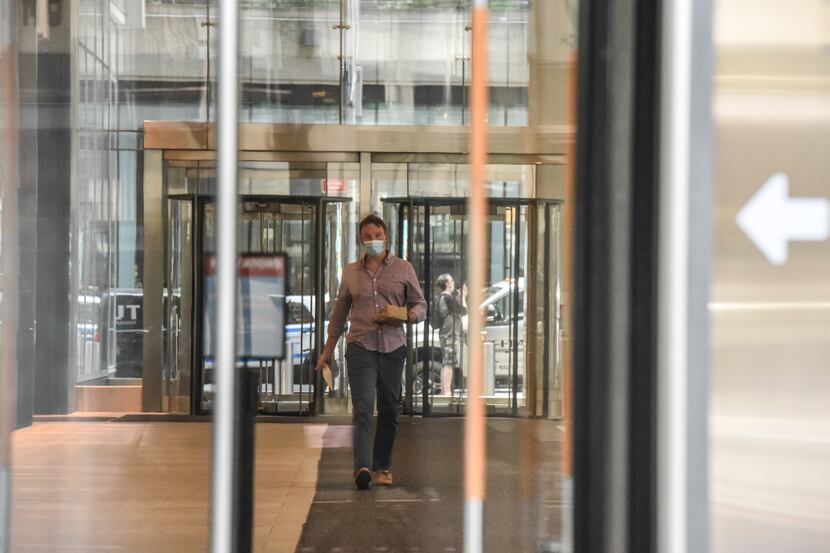As COVID-19 continues to surge here, UT Southwestern Medical Center is warning about “alarming” trends and urging residents to stay vigilant, especially around the July Fourth holiday.
Its doctors also had a message for business: Keep employees working at home if you can.
While that approach won’t fly in some industries, many others have embraced remote work. It’s helping them get through the pandemic and slowing the potential spread of the disease.
“Being able to do that for as long as possible — and wherever possible — is something to strongly consider,” said Dr. Julie Trivedi, an assistant professor of internal medicine and infectious disease.
UT Southwestern still requires employees to work from home if they can, and they’re not allowed to return to campus without approval from their supervisor. The company also prohibits domestic and international travel unless it’s “mission-critical.”
For those wanting to return to the workplace, “The important thing is to do it slowly,” said Dr. Mujeeb Basit, assistant professor of internal medicine and cardiology. “The data will tell you where you are.”
He said he’s pleased with how UT Southwestern tapped the brakes in response to local developments: “We have slowed down our process in reopening as the [COVID-19] caseload has increased,” Basit said.
Remote work reduces personal interactions and mobility, which correlate with higher transmission rates. It’s also proved to be popular with employers because many have maintained high productivity during the pandemic. Currently, about half of U.S. workers are estimated to be working from home.
This may become a permanent state rather than a temporary condition, at least for a sizable share of the workforce. In a series of surveys by Mercer, a human resources consulting firm, a large share of employers have made remote work a feature of their long-range plans.
This month, almost 3 in 4 respondents said they were changing to allow more flexibility for remote work or to encourage a larger remote workforce.
When they bring people back, 44% of nearly 500 companies said they would let employees decide whether to return to the workplace or work at home.
“In April, a lot of companies were asking, ‘When do we get everybody back?’” said Terry Stone, who leads the health and life sciences group at consulting firm Oliver Wyman. “Now they’ve shifted to, ‘Who do we need to have back?’”
Companies could cut costs with remote workers, which would be valuable during a recession. One study put the savings at about $1,100 per employee who works at home half the time.
The strategy also protects the workplace against something employers cannot control: what workers do outside the company walls.
At least one local company is keeping people home longer amid fears that younger workers, who had flocked to Dallas bars, might expose more vulnerable employees. This week, a women’s soccer team from Orlando, Fla., withdrew from a tournament after 10 positive COVID-19 cases — reportedly traced to younger teammates visiting bars and nightclubs in Florida.
Last week, in a call with hospital systems and employers in the Dallas area, Stone asked about results from contact tracing. Many outbreaks, she said, reportedly came from social gatherings with family and friends.
“I’m not saying it never comes from work, but companies are doing a lot of the right things,” Stone said.
North Texas has community spread, and the number of confirmed cases — over 30,000 in Dallas, Tarrant, Collin and Denton counties — has nearly doubled since Memorial Day. By July 12, over 20,000 additional cases are projected for the four counties, according to Oliver Wyman’s COVID-19 Pandemic Navigator.
“All this further reinforces why you keep people working from home,” Stone said. “Then you don’t have to worry about that risk” of infecting co-workers at the office.
Attitudes about working from home have changed, in part because employees have been productive, in part because the pandemic hasn’t faded.
In April, Stone co-wrote a report on COVID-19 that encouraged companies to prepare for “the long haul of suppression.” For over a year, as case counts rise and fall, she expects communities to go through cycles of relaxing and tightening restrictions — with social distancing providing the only brake to slow the spread.
During that time, remote work will still be the norm, the report said. After vaccines and therapies have been developed, remote work will continue to be available.
“Nobody wants to snap back to normal,” Stone said. “What this has taught us is there are some things you can do remotely and maintain business momentum.”
While many companies said they don’t have issues with remote work, some managers worry about overseeing virtual teams and translating the corporate culture to remote settings. In addition, over one-third of companies told Mercer that employees were having mental health issues on account of social isolation and economic anxiety.
Current events, such as protests over police violence, add more stress — and all that bothers the bosses.
“One of their No. 1 concerns is their employees’ well-being,” said Angela Farley, chief operating officer for the Dallas Regional Chamber.
On Wednesday, the chamber is scheduled to host a virtual meeting on mental health and the workplace. It includes tools to help employers support workers — support she believes is needed now.
“Not being able to see folks, check in with people and even give ’em a hug — all these things are really taking a toll on the workforce,” Farley said.

